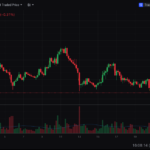Grid trading is a systematic and flexible trading strategy that thrives in markets characterized by volatility and predictable price ranges. Whether you’re navigating forex, crypto, or equities, grid trading offers a methodical way to profit from price fluctuations without needing to predict the market’s direction.
What Is Grid Trading?
At its core, grid trading involves placing multiple buy and sell orders at predefined intervals, creating a “grid” of trades. This strategy capitalizes on price movements within a range, allowing traders to profit from both upward and downward trends.
For example, imagine Bitcoin trading between $25,000 and $30,000. A grid trader might set buy orders every $500 below $30,000 and sell orders every $500 above $25,000. As the price fluctuates within this range, trades are executed automatically, locking in profits from each movement.
Why Choose Grid Trading?
- Works in All Market Conditions: Grid trading is effective in trending and sideways markets, making it a versatile tool.
- Emotion-Free Trading: Predefined rules eliminate emotional decision-making, ensuring disciplined execution.
- Passive Income Potential: Once the grid is set up, it can operate with minimal intervention, generating profits over time.
- Customizable Strategy: Traders can tailor grid parameters to align with their risk tolerance and market analysis.
How Does Grid Trading Work?
- Define the Range:
- Identify the upper and lower price limits for your grid.
- Use historical price data or technical analysis to determine the range.
- Set the Grid Size:
- Divide the range into equal intervals (e.g., $500 steps).
- Place buy and sell orders at each interval.
- Trade Execution:
- A buy order is executed when the price falls to a lower grid level.
- A sell order is executed when the price rises to an upper grid level.
- For example:
- Buy BTC at $25,500, $25,000, and $24,500.
- Sell BTC at $26,500, $27,000, and $27,500.
- Adjust as Needed:
- Monitor market conditions and adjust grid levels or range if necessary.
Advantages of Grid Trading
- Profits from Volatility: Every price movement within the grid generates a profit.
- No Market Direction Prediction: Grid trading doesn’t rely on whether the market is bullish or bearish.
- Automated Execution: Many trading platforms and bots can manage grid setups for you, saving time.
Challenges to Watch Out For
- Capital Requirements: A large range with many grid levels can tie up significant capital.
- High Volatility Risk: Sudden price spikes or crashes can disrupt the grid and result in losses.
- Market Breakouts: If the price exits the grid range, orders outside the range may remain unexecuted.
Tips for Effective Grid Trading
- Choose the Right Asset:
- Grid trading works best in assets with consistent volatility and a defined range (e.g., forex pairs, BTC/ETH).
- Start Small:
- Experiment with a small range and fewer grid levels to understand the mechanics before scaling up.
- Leverage Automation:
- Use trading bots to manage orders and execute trades 24/7 without manual intervention.
- Risk Management:
- Diversify your grid trading setups across multiple assets or ranges to mitigate risks.
Grid Trading in Action: Example
Let’s say Ethereum is trading between $1,500 and $1,700. You decide to create a grid with the following parameters:
- Grid range: $1,500 to $1,700.
- Grid size: $50 intervals.
- Initial capital: $3,000.
You place:
- Buy orders at $1,650, $1,600, $1,550, and $1,500.
- Sell orders at $1,700, $1,750, and $1,800.
As Ethereum’s price fluctuates, buy and sell orders execute at different levels, generating profits with each completed cycle.
Is Grid Trading Right for You?
Grid trading is ideal for traders who prefer a structured and hands-off approach to capitalize on market volatility. However, it’s not without risks. Understanding the market, choosing the right parameters, and managing your capital wisely are key to success.
Final Thoughts
Grid trading offers a disciplined and systematic way to profit from market volatility. Whether you’re a seasoned trader or a beginner exploring automation, this strategy provides a unique opportunity to benefit from price fluctuations without requiring constant monitoring. However, as with any trading strategy, thorough research and proper risk management are essential.
Disclaimer
This article is for informational purposes only and does not constitute financial advice. Grid trading involves risks, and past performance does not guarantee future results. Always conduct your own research before making investment decisions.







